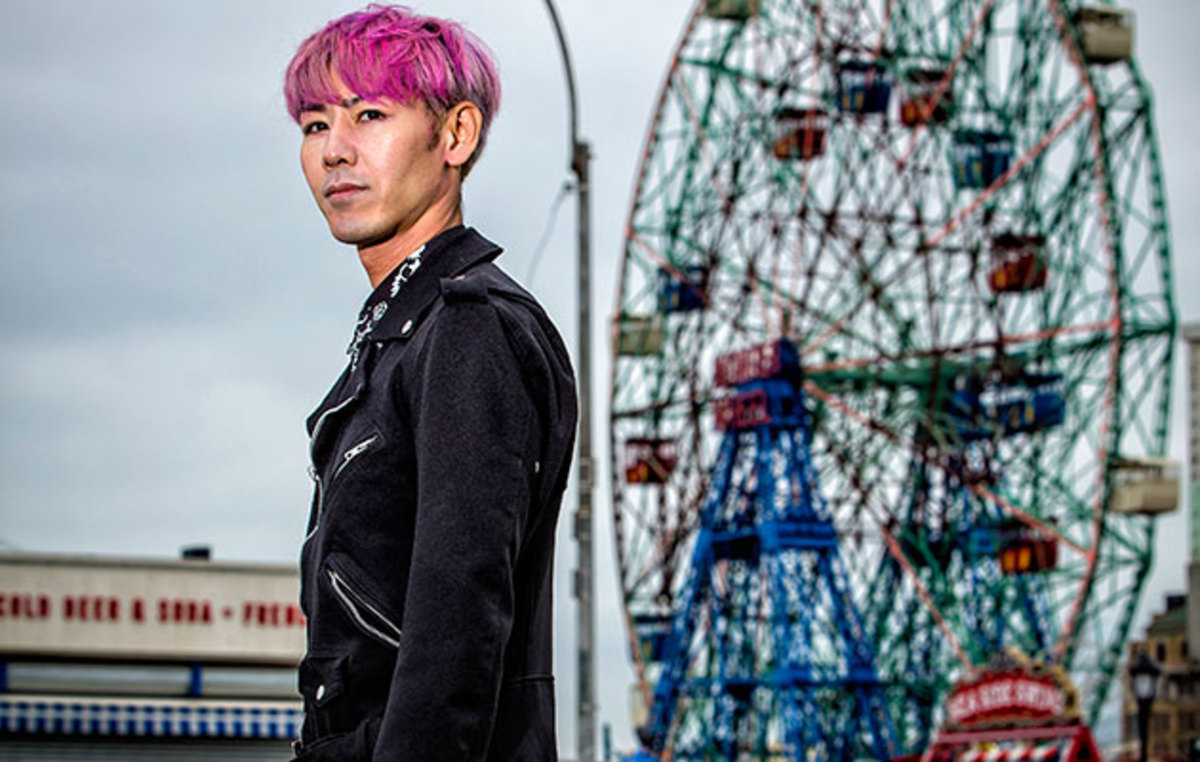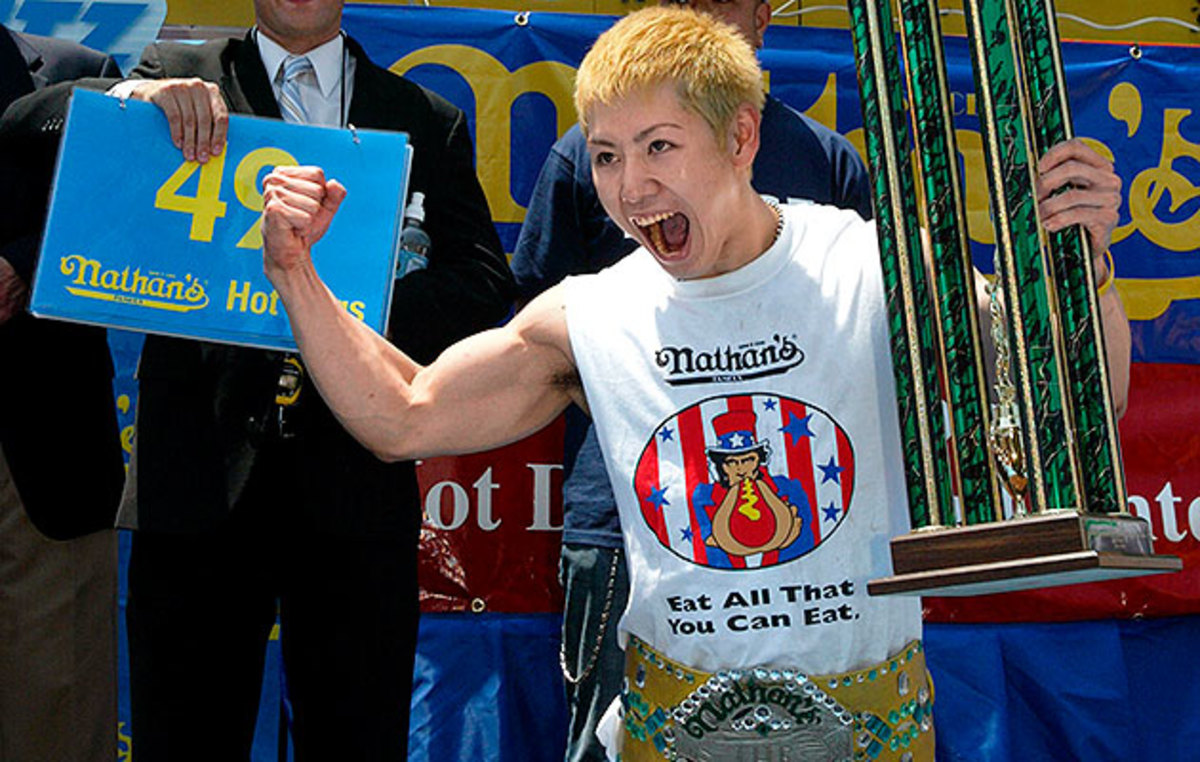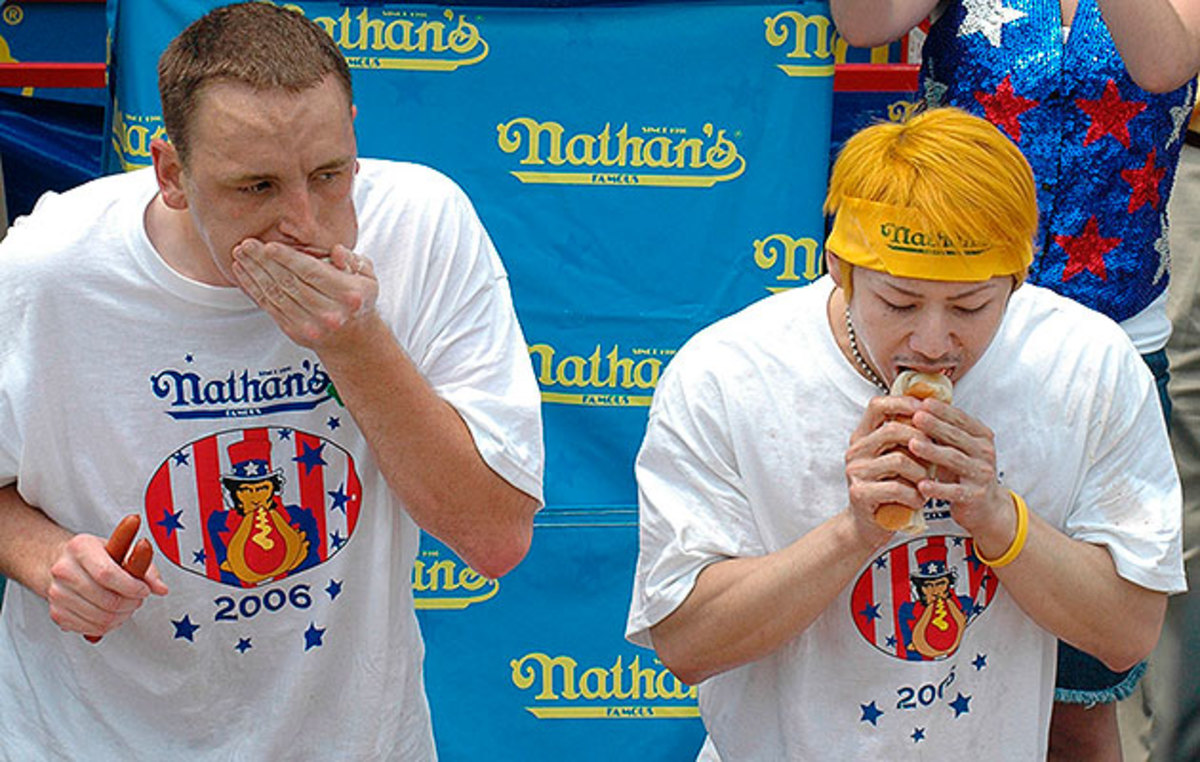Exiled from competitive eating’s biggest stage, Kobayashi forges on

There are 61 days, one hour and 35 minutes showing on the Nathan’s Wall of Fame countdown clock when Takeru Kobayashi returns to Coney Island for his first extended visit since 2010—the first since he was handcuffed and dragged off the same stage where he once reigned. Under clouded skies, the red-white-and-blue Nathan’s billboard towers over low-rise buildings, pretzel stands, diners and arcades, displaying a digital countdown to the next Fourth of July hot dog eating contest and the faces of every competitive-eating legend: Crazy Legs Conti, Eater X, The Black Widow. All of them except Kobayashi, who was unceremoniously effaced from the collage in ’11.
On a cold morning in May, Kobayashi reluctantly agrees to return to the neighborhood and face his demons, with the stipulation that he will not go near the Nathan’s storefront. The boardwalk is sparsely populated. Most of the storefronts are boarded up, all of the rides shut down.
Kobayashi arrives with his manager-translator-stylist-girlfriend, Maggie James. He is wearing a long black trench coat over a black-and-white shirt, black drop-crotch pants and metallic-buckle shoes. His hair is pink. His socks are decorated with brightly colored dinosaurs.
Before his photo shoot, Kobayashi sits on a bench and James drapes a towel over his shoulders. She applies lotion to his face and neck, touches up his cheeks with makeup, sprays product in his hair. Kobayashi talks about what’s changed since he broke off from Nathan’s and Major League Eating, the world’s largest governing body of competitive consumption, in 2010.
“The way they run things is imperialistic,” he says of MLE. “I feel like I have left that small world behind. Like it was a different lifetime.”
• SI’s Where Are They Now issue: This year’s stories, all in one place
Eventually Kobayashi is ready. He walks up and down the boardwalk, posing, smiling; he’s at peace in his old haunt. He climbs atop a metal railing, raising both arms over his head as he takes in the hazy ocean view. He chases pigeons down the beach even after the camera stops clicking, with a childlike innocence that belies his 38 years.
Then, abruptly, he stops in front of a trash can and stares inside. James asks what he is looking at, but Kobayashi says nothing and walks away. Within minutes, bumpy, red splotches break out on his neck. James is confounded—she checks the towel, the hair spray, the lotion for some offending agent.
Only later will Kobayashi admit what he saw in that trash can: a commemorative cup celebrating Nathan’s 100-year anniversary. “I think I have a Nathan’s allergy,” he says as the hives spread to his arms and legs. “It means I am probably not supposed to be here anymore.”

Company legend says that the Nathan’s Hot Dog Eating Contest has been held annually since 1916, but the record books go back only to ’72. That year a Brooklyn College student won by eating 14 hot dogs in 3 1/2 minutes. By 2000 the record had stretched to 25 1/8 in 12 minutes. In those days the event was populated mostly by portly New Yorkers, dilettantes who saw it as a one-day excursion into excess.
Then in 2001, Kobayashi—all 5' 7" and 131 pounds of him—arrived. The 23-year-old flew over from Japan the day before the event, having never before eaten a hot dog, and finished 25 of them in 5:13. He didn’t stop until he reached 50, doubling the previous record. “If you want to know the history of competitive eating,” says David O’Karma, an eater who consumed 17 hot dogs that year, “it starts right then.”
• From the Vault (2004): Nation’s fascination with competitive eating grows
Kobayashi’s performance was so outlandish that the numbered placards flashed to show the eaters’ scores didn’t reach digits high enough; the scorekeeper had to start writing Kobayashi’s totals on pieces of paper. Some competitors simply put their hot dogs down and stared.
“It was a mesmerizing inhalation of food, a ballet of gurgitation,” O’Karma says. “It was like I had seen a UFO. It was like Close Encounters of the Third Kind. Nothing was the same after that.”
Kobayashi had been meticulously, maniacally honing his strategy for months. He broke his hot dogs in half with one hand, and with the other dunked the buns in water. He then gyrated his entire body as he funneled them down his throat. This combination of moves would later become known as the Solomon Method—now almost universally used—and the Kobayashi Shake.

It’s been more than a week since his Coney Island visit, and Kobayashi and James are having dinner on the patio of a Brooklyn restaurant. His hives subsided just two days earlier, and despite eating only a bagel all day, Kobayashi is not hungry. Actually he is never hungry. Sometimes he goes days without eating, until he seems faint and James has to remind him. “He is broken,” she says.
Over dinner Kobayashi shares the story of his life, with James often cutting him off mid-sentence to clarify or elaborate on what she thinks he means. The dynamic of their relationship is inscrutable. “I have always had a woman taking care of me,” Kobayashi says after James slices the grilled octopus on his plate. This he attributes to being raised by his mother and two older sisters.
The first eating competition Kobayashi won was a milk chugging contest in grade school. When he was in college, he entered a restaurant’s curry-rice-eating challenge and more than tripled the amount needed to win. Soon he was appearing regularly on a popular Japanese show called TV Champion. After dominating the country’s nascent competitive-eating circuit for a year, he suggested to the TV Champion execs that they should stage a contest in which the winner would be flown out to Coney Island to compete at Nathan’s. They agreed, and he won.
In the months before he left for New York City, Kobayashi experimented with different eating methods, videotaping his training sessions and charting and analyzing various techniques—a mad scientist consumed by a most unusual pursuit. Since hot dogs were not readily available in Japan, he was able to practice only with fish sausages.
• Where Are They Now: Refrigerator Perry mired in a stubborn spiral
After six straight years of winning at Nathan’s, Kobayashi lost to Joey Chestnut in 2007, 66–63. That competition took place four months after Kobayashi’s mother died, and mere weeks after he suffered a serious jaw injury from overtraining that still ails him to this day. But then he lost to Chestnut again in ’08. And then again in ’09.
Things became farcically convoluted in 2010. As Kobayashi tells it, when he notified George and Richard Shea, cofounders of MLE, that he was moving to America, they tried to get him to sign their standard contract for U.S. residents. The deal would have barred him from participating in any non-MLE-sanctioned competitions, and precluded him from making appearances in which he did anything related to eating or that conflicted with a Nathan’s sponsor.
“They want to control the world,” Kobayashi says.
George Shea says that the contract did not materially change from previous years—Kobayashi and James vehemently deny this. They also disagree on how much money was offered, and on virtually every other aspect of how the negotiations fell apart.
“There is a huge conflict of interest based on the fact that they are the governing body of the league and also want to act as your manager,” says Patrick Bertoletti, a former No. 2–ranked eater in MLE who split from the league in 2013. “It is kind of bulls---.”
Although Kobayashi refused to sign the contract before the 2010 competition, he showed up in the crowd wearing a black T-shirt with FREE KOBI on the front. After the contest was finished, he climbed aboard the stage—holding a backpack full of hot dogs, prepared to hold his own eating exhibition—and was swarmed by police. In a scene alternately described by onlookers as sad and surreal, Kobayashi grasped the blue Nathan’s barricades as he was dragged from the platform, ultimately spending the night in jail.
“As great as he was for competitive eating, and as responsible as he was for making it a sport,” Chestnut says, “he made it weird again right then.”

A small crowd has gathered on a Friday night in March, coiled three deep around the ring, as Kobayashi takes center stage. It’s been six years since the arrest, 10 since his last win at Nathan’s. But Kobayashi is not here to eat. He is making a pro bono appearance at a charity event at SPiN, a Ping-Pong club in Manhattan, where a $50 donation allows you to spar with pro boxer Boyd Melson.
“We have a very special guest,” the emcee for the event bellows. “A Guinness World Records titleholder. Fighting out of Japan, by way of Brooklyn. . . .”
Kobayashi reluctantly enters the ring in boxing gloves. He bounces around with Melson, feigning punches. After about three minutes they both simultaneously fall to the ground, a double knockout à la the ending of Rocky II.
For the next few hours the notoriously shy Kobayashi retreats to the outskirts of the club. Fans approach intermittently. One woman tells him that she had a hot dog for dinner. A middle-aged man begins to pat Kobayashi’s stomach; he obliges by undulating it in and out. Mostly Kobayashi just nods and smiles. At one point he reveals a pair of long white socks, replete with images of hot dogs. Near the end of the evening a man in his early 20s approaches. “Oh, man, I used to watch you on ESPN when I was growing up,” he says. “You’re one of the few athletes we know by just one name: Jordan, Kobe, Kobayashi.
“So, what have you been doing?”
***
Kobayashi gets animated when talking about his current and future endeavors. He rarely eats competitively anymore, maybe three or four events a year. Yet he is far from retired. Every year since the arrest he has held his own Fourth of July hot dog eating competition. In 2011 he ate 69 hot dogs on the rooftop of a Manhattan club, while a large projector screen behind him simultaneously displayed the Nathan’s competition. Kobayashi claimed a world record. Shea called it “a farce.”
Kobayashi staged similar one-man competitions in both 2012 and ’13. In ’14 he switched it up and ate 113 bunless hot dogs, and last year he broke the record for most hot dogs eaten while playing Ping-Pong (35). The most challenging part of being an independent eater, he says, is organizing these events: securing sponsors, attracting an audience.
He says he earns most of his money from appearance fees. In recent years he has traveled to Singapore, Taiwan, China, Brazil, Turkey, Indonesia, Puerto Rico and Italy. In the U.S., most of these are small events, ranging from eating pizza at some bros’ Super Bowl party, to cupcakes at a self-storage facility, to hot dogs versus a hamster eating miniature hot dogs. Yet Kobayashi says that he’s happier than ever, eating better than ever and making more money than ever.
In April he returned to Japan to film a reunion show with all of the old Japanese competitive eaters. Kobayashi, the only one who has not retired, won. Earlier in the year he traveled to the small island country of Palau as a personal guest of president Tommy Remengesau. Kobayashi plans to return in October to help with his re-election campaign.
“It is so clear that our opportunities would have been slayed if we had signed with [MLE],” James says. “There is no comparison with what we would have lost.”
Kobayashi did not know what he would do this Fourth of July after the plans for what James calls a “big event” in Chicago fell apart. James says they did not have enough time to put together a major competition, but because “Kobi is so known for hot dogs, he has to do something.” So on short notice they set up an eating demonstration at the Brooklyn Navy Yard.
What they are both most excited for, however, is what they talk least about. James says that Kobayashi is “kind of in the process” of opening his own hot dog restaurant. She is cagey when discussing these plans but says they should be able to share more soon.
“Competitive eaters don’t want to do eating contests for the rest of their lives; it’s not sustainable or healthy,” Bertoletti says. “Kobi is looking for that exit strategy.” It has so far proved elusive; twice in the last five years Kobayashi had tried and failed to create his own line of hot dogs. Even now he sheepishly admits that “opening a restaurant is a lot more difficult than I thought.”
“I think his whole life is being a competitive eater,” Chestnut says. “I feel for him.”
Every year the Shea brothers approach Kobayashi with hopes of getting him to come back; even George concedes that he still “has such a star quality.” Kobayashi won’t rule out returning to the Nathan’s stage, but only if he can sign a one-day contract with MLE. He also says that his desire to defeat Chestnut has subsided after his former rival fell to Matt Stonie last summer, ending his eight-year winning streak.
“I wanted to beat him before he lost his peak,” Kobayashi says.
Which then raises the obvious question: Who is the best competitive eater in the world right now?
“I am,” Kobayashi says. “Of course.”
What about of all time?
“Of course, I am.”
